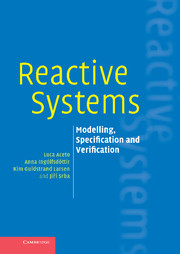Book contents
- Frontmatter
- Contents
- Figures and tables
- Preface
- I A Classic Theory of Reactive Systems
- II A Theory of Real-time Systems
- 8 Introduction
- 9 CCS with time delays
- 10 Timed automata
- 11 Timed behavioural equivalences
- 12 Hennessy–Milner logic with time
- 13 Modelling and analysis of Fischer's algorithm
- Appendix A Suggestions for student projects
- References
- Index
13 - Modelling and analysis of Fischer's algorithm
from II - A Theory of Real-time Systems
Published online by Cambridge University Press: 17 March 2011
- Frontmatter
- Contents
- Figures and tables
- Preface
- I A Classic Theory of Reactive Systems
- II A Theory of Real-time Systems
- 8 Introduction
- 9 CCS with time delays
- 10 Timed automata
- 11 Timed behavioural equivalences
- 12 Hennessy–Milner logic with time
- 13 Modelling and analysis of Fischer's algorithm
- Appendix A Suggestions for student projects
- References
- Index
Summary
Introduction
Mutual exclusion algorithms, like those we discussed in Chapter 7, have an abstract behaviour described by the following pseudocode:
while true do
begin
remainder region
trying region
critical section
exit region
end
It is supposed that such algorithms satisfy the following two properties.
Mutual exclusion No two processes are in their critical sections at the same time.
Deadlock freedom If some process is in its trying region then eventually some process is in its critical section. (Note that the process in the critical section might be different from the one initially in its trying region.) Moreover, if a process is in its exit region then that process will eventually enter its remainder region.
As stated in Lynch and Shavit (1992), the known asynchronous mutual exclusion algorithms for n processes require O(n) read and write registers and O(n) operations to access the critical section. These bounds make them rather impractical for large-scale applications, where the number of processes could be very large. This raises the question whether it is possible to achieve mutual exclusion in asynchronous systems consisting of n processes by using a smaller number of shared registers and/or fewer than O(n) operations to access the critical section. Unfortunately, this is impossible for ‘classic reactive systems’ in an asynchronous setting. In fact, Burns and Lynch (1980, 1993) showed the following theorem.
- Type
- Chapter
- Information
- Reactive SystemsModelling, Specification and Verification, pp. 248 - 260Publisher: Cambridge University PressPrint publication year: 2007

